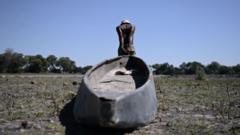As capybaras charm social media, their presence in Nordelta raises pressing ecological concerns.
**Capybara Conundrum in Nordelta: Too Many Rodents in a Gated Community?**

**Capybara Conundrum in Nordelta: Too Many Rodents in a Gated Community?**
In a wealthy enclave near Buenos Aires, residents navigate the growing capybara population with sedatives and sterilization.
In a peculiar clash between nature and luxury living, the residents of Nordelta, a prosperous gated community north of Buenos Aires, are facing an unusual challenge: the overwhelming presence of capybaras, the largest rodents in the world. These charming creatures, loved globally for their relaxed demeanor and social behavior, have multiplied significantly within the confines of this affluent suburb, leaving some residents delighted and others distressed.
Vet Luciano Sampietro has been at the forefront of this issue. Armed with a blow dart, he tranquilizes capybaras to facilitate their sterilization, a necessary step as the creatures have become too numerous for the community's environmental balance. One such day saw him tending to a hefty alpha male and a pregnant female. Once sedated, the female had to be treated immediately to prevent further reproduction.
Capybaras, native to South America, have surged in popularity online, seen in countless viral videos exhibiting their affable nature alongside other animals. Yet, here in Nordelta, their growing numbers are leading to tensions regarding property damage and ecological disruption. While the critters are welcomed by some, others express frustration over the invasive nature of their burgeoning population.
The conflict has deepened as the community continues to expand, with areas once reserved for wildlife turned into luxury accommodations and leisure spaces. This encroachment has pushed capybaras to adapt to urban life, challenging the residents’ expectations of an idyllic living environment without the interjection of natural wildlife.
In this unique ecosystem, the charming capybara's public persona contrasts starkly with the real-world implications of their proliferation. As the city grapples with both admiration and annoyance at the capybara invasion, the question remains: how can a community reconcile its luxurious lifestyle with the natural behaviors of its wild inhabitants?
Vet Luciano Sampietro has been at the forefront of this issue. Armed with a blow dart, he tranquilizes capybaras to facilitate their sterilization, a necessary step as the creatures have become too numerous for the community's environmental balance. One such day saw him tending to a hefty alpha male and a pregnant female. Once sedated, the female had to be treated immediately to prevent further reproduction.
Capybaras, native to South America, have surged in popularity online, seen in countless viral videos exhibiting their affable nature alongside other animals. Yet, here in Nordelta, their growing numbers are leading to tensions regarding property damage and ecological disruption. While the critters are welcomed by some, others express frustration over the invasive nature of their burgeoning population.
The conflict has deepened as the community continues to expand, with areas once reserved for wildlife turned into luxury accommodations and leisure spaces. This encroachment has pushed capybaras to adapt to urban life, challenging the residents’ expectations of an idyllic living environment without the interjection of natural wildlife.
In this unique ecosystem, the charming capybara's public persona contrasts starkly with the real-world implications of their proliferation. As the city grapples with both admiration and annoyance at the capybara invasion, the question remains: how can a community reconcile its luxurious lifestyle with the natural behaviors of its wild inhabitants?



















